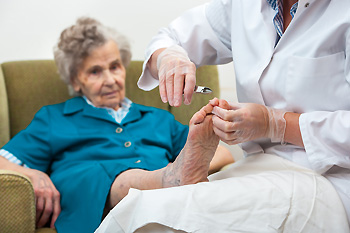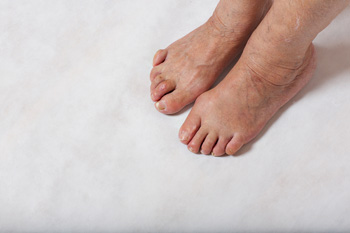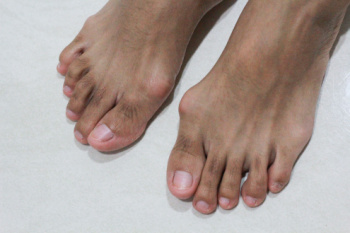
As we age, changes in circulation, skin health, and nerve function can increase the risk of foot problems. Regular foot exams help detect issues early, such as skin breakdown, poor circulation, deformities, or loss of sensation. These changes can lead to serious complications if not addressed promptly. During a foot exam, a podiatrist checks for signs of corns, calluses, ulcers, nail disorders, and circulation problems. They also assess for conditions like neuropathy, arthritis, or balance issues that can affect mobility and increase the risk of falls. Routine foot care and exams are an important part of staying active and independent. Older adults with diabetes, vascular disease, or difficulty trimming their nails benefit especially from regular professional care. If you or a loved one are experiencing foot discomfort or mobility issues, it is suggested that you schedule an appointment with a podiatrist to ensure early diagnosis and proper treatment.
If you need your feet checked, contact Philip Hahn, DPM of Advanced Foot & Ankle Center. Our doctor will attend to all of your foot and ankle needs and provide you with quality treatment.
Geriatrics and Podiatry
When people age, some common issues that may occur are bone density loss, dry skin, poor circulation, and rough brittle nails. These issues may also affect your foot health if the necessary steps are not taken to alleviate the problems.
It is important to take care of your feet because feet that are injured or diseased can affect your overall health. Having painful feet hinders your ability to do daily activities or may decrease your willingness to do the things that you need to do.
Visiting Your Geriatrician
As we age, health problems become more likely, so it is essential to visit your doctor for check-ups to ensure that you are doing the best you can to take care of your health. It is recommended to check your feet frequently for any possible cuts, bruises, swelling, corns or any other irregularities.
Taking Care of Elderly Feet
Cracked or dry feet can be treated by applying moisturizer often. It is also important not to wear old socks because the older the sock is, the higher the possibility there will be that there is bacteria there. Wear fresh socks and make sure they fit properly.
Proper foot health means that you can have a more active lifestyle and you will not be bogged down by pain. Foot health also leads to good circulation, which is paramount for overall health.
If you have any questions, please feel free to contact our office located in Texarkana, TX . We offer the newest diagnostic tools and technology to treat your foot and ankle needs.

When it comes to correcting rigid hammertoe deformities, surgery often includes the use of implants to help straighten and stabilize the toe. One important decision in this process is whether to use a permanent implant or one that can be removed later. Permanent implants are designed to stay in place indefinitely, providing long-term support and alignment. They are often chosen for their durability and the convenience of not requiring a second procedure for removal. Removable implants offer flexibility. Once the toe has healed in the proper position, these implants can be taken out, leaving the body free of foreign materials. The choice between permanent and removable implants depends on several factors, including the severity of the deformity, the patient’s lifestyle, and overall health. If you have a painful rigid hammertoe, it is suggested that you obtain a personalized consultation with a podiatrist who will help you determine the most appropriate solution for its correction
Hammertoe
Hammertoes can be a painful condition to live with. For more information, contact Philip Hahn, DPM from Advanced Foot & Ankle Center. Our doctor will answer any of your foot- and ankle-related questions.
Hammertoe is a foot deformity that affects the joints of the second, third, fourth, or fifth toes of your feet. It is a painful foot condition in which these toes curl and arch up, which can often lead to pain when wearing footwear.
Symptoms
- Pain in the affected toes
- Development of corns or calluses due to friction
- Inflammation
- Redness
- Contracture of the toes
Causes
Genetics – People who are genetically predisposed to hammertoe are often more susceptible
Arthritis – Because arthritis affects the joints in your toes, further deformities stemming from arthritis can occur
Trauma – Direct trauma to the toes could potentially lead to hammertoe
Ill-fitting shoes – Undue pressure on the front of the toes from ill-fitting shoes can potentially lead to the development of hammertoe
Treatment
Orthotics – Custom made inserts can be used to help relieve pressure placed on the toes and therefore relieve some of the pain associated with it
Medications – Oral medications such as anti-inflammatories or NSAIDs could be used to treat the pain and inflammation hammertoes causes. Injections of corticosteroids are also sometimes used
Surgery – In more severe cases where the hammertoes have become more rigid, foot surgery is a potential option
If you have any questions please contact our office located in Texarkana, TX . We offer the newest diagnostic and treatment technologies for all your foot and ankle needs.

Bunions are bony bumps that form at the base of the big toe, caused when the big toe angles inward toward the second toe. This misalignment can lead to pain, swelling, and redness around the affected area, especially when wearing tight shoes. As the bunion worsens, the big toe may become increasingly deformed, making it difficult to find comfortable footwear. Bunions are often caused by genetics, but factors like wearing ill-fitting shoes, high heels, or having flat feet can contribute to their development. The condition may feel tender or throbbing, particularly after standing or walking for extended periods. A podiatrist can help by assessing the severity of the bunion and recommending appropriate treatment options. Non-surgical treatments include wearing orthotic devices, padding, and adjusting footwear to reduce pressure on the toe. In more severe cases, a podiatrist may recommend surgery to realign the toe and provide long-term relief. If you have a bunion, it is suggested that you schedule an appointment with a podiatrist.
If you are suffering from bunions, contact Philip Hahn, DPM of Advanced Foot & Ankle Center. Our doctor can provide the care you need to keep you pain-free and on your feet.
What Is a Bunion?
A bunion is formed of swollen tissue or an enlargement of boney growth, usually located at the base joint of the toe that connects to the foot. The swelling occurs due to the bones in the big toe shifting inward, which impacts the other toes of the foot. This causes the area around the base of the big toe to become inflamed and painful.
Why Do Bunions Form?
Genetics – Susceptibility to bunions are often hereditary
Stress on the feet – Poorly fitted and uncomfortable footwear that places stress on feet, such as heels, can worsen existing bunions
How Are Bunions Diagnosed?
Doctors often perform two tests – blood tests and x-rays – when trying to diagnose bunions, especially in the early stages of development. Blood tests help determine if the foot pain is being caused by something else, such as arthritis, while x-rays provide a clear picture of your bone structure to your doctor.
How Are Bunions Treated?
- Refrain from wearing heels or similar shoes that cause discomfort
- Select wider shoes that can provide more comfort and reduce pain
- Anti-inflammatory and pain management drugs
- Orthotics or foot inserts
- Surgery
If you have any questions, please feel free to contact our office located in Texarkana, TX . We offer the newest diagnostic and treatment technologies for all your foot care needs.





